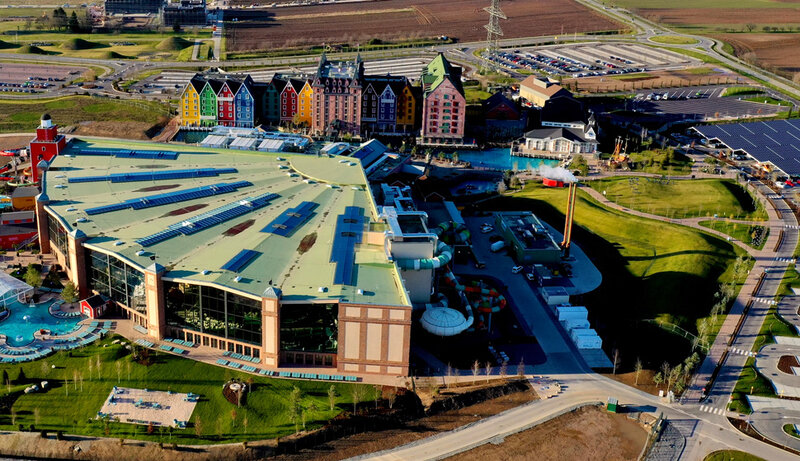Supplying heat to the Europa Park’s New Water World
Follow-up order five years after the first
Facts & figures

Follow-up order for Europa Park theme park: Following the successful installation of two 2G plants in Germany’s largest theme park in 2014, the family-owned company commissioned the new installation of two other CHPs for its new Rulantica water world experience. To optimize their efficiency, they use combined heat, power and cooling and, thanks to the additional heat extraction on the mixture cooler and a combustion heat exchanger, the CHPs offer an overall volumetric efficiency of almost 95 percent.
The Rulantica water world experience is the latest attraction to be added to Germany’s largest theme park, Europa Park in November 2019. This water world with its Scandinavian charm awaits guests with nine themed areas and 25 attractions. The central feature is its 20-meter high, shell-shaped hall with a 32,600 m² indoor water world for families to enjoy – and presenting a large and all-yearround thermal load due to the enormous quantities of water and air in the building. Other consumers of heat include an outdoor pool, a heated wild water stream and – alongside other attractions – the on-site gastronomy services as well as the 4-star superior hotel “Krønasår – The Museum Hotel”.
All-year-round utilization of thermal energy
In order to cover the heating requirements in a profitable and environmentally-friendly way, those responsible at the theme park decided to purchase two natural gas CHPs which cover the baseload and three boilers to cover peak loads. The CHPs from 2G not only deliver the heat required for warm water supply, they also provide heating energy. In summer, when no heat is required for heating and less energy is needed for heating water, the thermal energy is also used: The hotel’s air-conditioning also benefits because an absorption chiller has been installed to ensure efficient combined heat, power and cooling. “In this way, we can use the heat generated by the CHPs efficiently the whole year round,” says Thomas Renner- Boh, who was one of those responsible for the construction of the new water world at Europa Park. The power generated by the power plants is used directly in the water world.
To meet the high thermal baseload of the water world, two avus 500b motors are used in the CHPs. They provide a maximum electrical output of 670 kW each and 933 kW thermal power. Besides waste heat, the additional extraction of heat from the mixture cooler and a combustion heat exchanger, the plant offers an extremely high volumetric efficiency of almost 95 percent.


Additional heat extraction for more efficiency
An efficient use of fuel was very important to Europa Park for two reasons: The all-yearround use of the CHP as well as the company’s own sustainability targets were convincing arguments for an extremely efficient use of natural gas. The company decided to pursue an economical yet climate-friendly energy supply. In Europa Park for example, the use of geothermal power, photovoltaic systems and a water power plant generate a high volume of regenerative energy. The energy plants at Europa Park were supplemented with two CHPs which were also supplied by 2G in 2014 (2 x agentitor 206 each with approx. 220 kWel and 260 kWth) and by the simultaneous generation of power and heat which deliver a significantly lower CO2 footprint than heat generation in boiler plants with the purchase of electricity.
High thermal load caused by warm water treatment
The decision to commission 2G again with the project was partly due to the positive experience with the existing plants in Europa Park. Renner-Boh: “Both of the agenitor generators are running extremely smoothly. This has strengthened our trust in 2G. Obviously when awarding the contract for the CHPs for the water world, excellent value for money and high efficiency were also factors influencing our decision.”
Silent in operation: The CHP is under cover
Another criterion was that 2G understands how to construct quiet combined heat and power plants which the company had already put to the test with the existing systems. In the water world, the aspect of noise is particularly important because the energy plant is just ten meters away from the Krønasår Hotel. On the building’s cover, the engine noises of the CHPs should be virtually unnoticeable. 35 decibels at a ten meter distance was the specified limit, virtually no louder than a quiet whisper. “The need for silent operation of the CHP engine was realized with a noise hood which was custommade by 2G,” reports Renner-Boh who praises the design: “It has such spacious dimensions that the service technicians can move around under the cover without any problem.”
Full service for maximum availability
The all-year-round use of the CHP highlights the importance of another aspect, namely reliability. To ensure the 24x7 availability of the plant, Europa Park signed a full service agreement with 2G. 2G is not only responsible for regular maintenance but for on-call services as well. To ensure any irregularities from standard operation can be rectified as quickly as possible, the operating data and status messages of the CHP are sent to the 2G headquarters in Heek. Irregular operating conditions can be detected easily and the parameters can be corrected from the remote location. This optimization reduces costs and increases operational readiness. This is not the only reason why Renner-Boh is confident that the CHP will meet or indeed exceed the expectations of the theme park owners. “I’m in no doubt that our plants in the water world will be kept in constant operation for 8,000 or more operating hours a year.”




